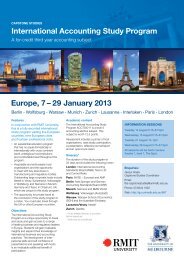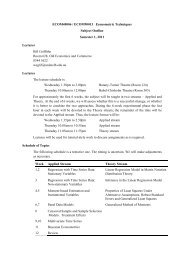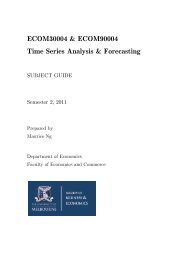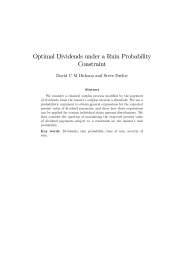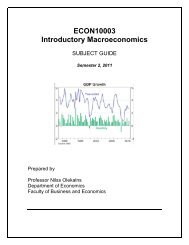A Model of Optimal Corporate Bailouts - Faculty of Business and ...
A Model of Optimal Corporate Bailouts - Faculty of Business and ...
A Model of Optimal Corporate Bailouts - Faculty of Business and ...
Create successful ePaper yourself
Turn your PDF publications into a flip-book with our unique Google optimized e-Paper software.
In sum, when restarts are unpr<strong>of</strong>itable, the firm’s optimal first-period investment strategy isρ ∗ = IN if Π| ρ2≥ 0 ,=OUT1OUT otherwise .Subcase 2: Firm Restarts Project With Different Manager. Now suppose that π ∗( 0, 0 ) ≥20, so that the firm restarts, <strong>and</strong> assume as well that the firm could commit to fire the incumbentmanager after an initial failure. Thus, at time 1, the manager continues to view this as asingle-period game (at least for her), with pay<strong>of</strong>f <strong>of</strong>M ≡ e 1·w 1 − c·e2 12 .Consequently, her first-period effort remains e ∗ 1 ( w 1 ) = w 1 /c. In contrast, the firm anticipatesoperating in the second period under a different manager. Its continuation pr<strong>of</strong>it is thusΠ| F F=FIRE( e 1 ) = e 1·(R − w 1 ) + (1 − e 1 )·π 2 ( 0, 0 ) R 2 − 4·c·I 2 · c − w1=+ w 1· R − w 1− I4·c 2 1 ,cwhich implies a pr<strong>of</strong>it-maximizing wage <strong>of</strong> w ∗ = R + I 1 2/2 − R 2 /(8·c). Thus, the manager exertsfirst-period effort <strong>of</strong>e ∗ 1 = R + I 22·c− R28·c 2 ,yielding maximized pr<strong>of</strong>its <strong>of</strong> Π| F F=FIRE( e ∗ ) (Appendix equation A.1). Note that when the firm1can pr<strong>of</strong>itably restart, it optimally sets lower-powered first-period incentives than it wouldin the absence <strong>of</strong> the restart option. 16 Intuitively, restarting gives the firm a “second bite atthe apple,” which reduces the importance <strong>of</strong> first-period success. The firm therefore reducesfirst-period wages (<strong>and</strong> with it, managerial effort). From the incumbent manager’s perspective,the restart option makes her worse <strong>of</strong>f, because it depresses her first-period wage. The restartbenefits accrue to the firm <strong>and</strong> the replacement manager through the second-period pay<strong>of</strong>fs.Subcase 3: Firm Restarts Project With Same Manager. Finally, suppose once againthat π 2 ( 0, 0 ) ≥ 0, so that the firm restarts, but now the incumbent manager is retained. In thiscase, the manager’s pay<strong>of</strong>f isM ≡ e 1·w 1 − c·e2 12 + (1 − e 1)·m ∗ 2 = e 1·w 1 − c·e2 12 + (1 − e 1)· R28·c ,16 To see this, compare the effort level in the ab<strong>and</strong>onment case to the above expression:e ∗ 1 | ρ 2 =OUT = R2·c> R + I 22·c− R28·c 2 = e∗ 1 | ρ 2⇔ R2=IN4·c − I 2 > 0 .} {{ }π ∗ 2 ( 0,0 )15



